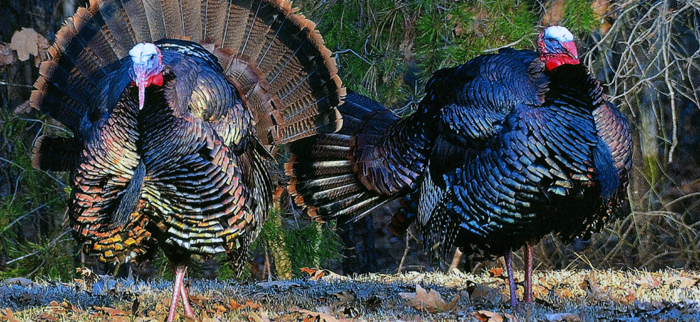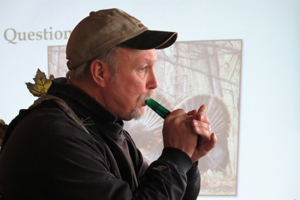Talkin’ Turkey: A wildlife success story

Turkeys in Cambridge; by Lori Bramble
You want to talk turkey? Talk to Frank Ryan.
The Reisterstown resident has seen them at their lowest point, when the state’s wild turkey population hovered near 2,000. And he’s watched with pride as their numbers puffed up like a tom in full strut to about 35,000 birds.
“It’s good to see the flocks thriving and prospering. If people take care of them, they’ll be around for a long time,” says Ryan, who spent 40 years as a Maryland Park Service ranger and a Maryland Natural Resources Police officer. “They are a testament to the good work the agency does.”

Ryan teaching a workshop
Indeed, wild turkeys join black bears and striped bass and others on the endangered list that have been revived in Maryland through careful management as well as public involvement.
“Wild turkey lack the charismatic appeal of bears, deer and geese, but the recovery of this great bird remains one of the greatest wildlife conservation success stories in history,” says Paul Peditto, director of the department’s Wildlife and Heritage Service. “The annual strut and gobble of an adult tom signals the arrival of spring and reminds us of the remarkable work of our wildlife management team.”
As a park ranger, Ryan helped that effort by trapping wild birds on state lands and relocating them to places where scientists predicted they would blossom.
As a Natural Resources Police officer, he protected those new flocks from poachers.
And as a hunter, Ryan reaped the benefits of those efforts, harvesting a turkey in each of Maryland’s 23 counties—an accomplishment that could never have happened 25 years ago.
Natural resources devotee
Ryan’s enthusiasm for the Department of Natural Resources and wild turkeys came naturally. He grew up hunting small game and fishing near his family’s home just north of Annapolis, where many of his neighbors worked at the department.
“I was a Natural Resources groupie by the time I was eight years old,” he says.
His dad was an avid hunter and fisherman who subscribed to the Pennsylvania Game News, a publication Ryan devoured as a youngster. He was especially drawn to the stories about wild turkeys and the men who hunted them.
Just before his 20th birthday in the fall of 1969, the pages of that Pennsylvania magazine became reality when Ryan killed his first turkey at Indian Springs Wildlife Management Area in Washington County, Maryland.
“It’s not much of a story,” he says, chuckling. “I was sitting on a rock at the edge of a ravine and it flew by.”
That next spring, Maryland held its first limited spring gobbler season, and as the population grew and spread, so did the season.
Growing gobblers
During that time, Ryan, who was working as a ranger at Cunningham Falls State Park, began teaching hunting seminars.
“It was slim pickings at that time, so the seminars weren’t about killing turkeys; they were about getting people to appreciate them,” he says.
| According to the National Wild Turkey Federation, turkey hunters spend more than $4 billion a year on calls and other gear. In Maryland, they add nearly $5 million to the economy annually. |
The bird’s revival got a major push in 1973 with the formation of the National Wild Turkey Federation, which began promoting more efficient ways to expand the flocks. To that point, Maryland and other states were failing in their efforts to release farm-raised birds into the wild, where lacking survival instincts or defensive mechanisms, they quickly perished.
The federation urged local biologists to trap wild birds with nets and relocate them. It also encouraged species conservation and habitat protection.
Armed with that new strategy, “We transferred turkeys all throughout the state,” Ryan says.
Those trapped near Fort Frederick were relocated to Patapsco Valley State Park. Some from Muddy Creek in Garrett County found new homes at Morgan Run in Carroll County. Once established, some of the Morgan Run flock was trapped and sent to Aberdeen north of Baltimore and Nanticoke on the Eastern Shore.

Ryan with robo-turkey
Wily white meat
As he hunted, Ryan marveled at the comeback. After bagging turkeys in five counties, he challenged himself and his skills to take a bird in each of the 18 remaining counties.
It’s not as easy as it sounds. Contrary to myth, turkeys are wily and easily spooked. They know the lay of the land and can disappear like a wisp of smoke in a breeze.
“Their brains are the size of a walnut, but they’re tough and many times they’ve outfoxed me,” Ryan says.
In 2006, he took his largest bird—a 25 pounder—in Prince George’s County. Mounted by a taxidermist and animated by a battery pack, it became a robo-turkey decoy for the Natural Resources Police to catch poachers.
On May 22, 2014, he ended his quest with a gobbler in Harford County.
Laying the groundwork was the secret to Ryan’s success: scouting the hunting area the year before; getting written permission from the landowner; walking the area to familiarize himself with the habitat and turkey behavior; and noting physical barriers between his chosen hunting spot and his potential prey.
“The best part of the sport is calling them in close,” explains Ryan, who still uses a small, battered box call. “It’s something about the call that gets the senses humming like a Stradivarius.”
However, the wild turkey recovery won’t remain successful without vigilance and more hard work. Experts estimate that 6,000 acres of habitat disappear nationally each day. Hunters, who fund many conservation efforts through license fees, are dwindling in number and are now less than 10 percent of the American population.
“We can continue the success story. Wise wildlife management, sportsmen and landowners who were knowledgeable enough and generous enough got us to this point,” Ryan says. “Now we have to keep public opinion on our side. With positive public opinion, we can do anything. Without it, we can do nothing.”
Article by Candy Thomson—Natural Resources Police public information officer.
Appears in Vol. 19, No. 1 of the Maryland Natural Resource magazine, winter 2016.


 1-888-373-7888
1-888-373-7888 233733
233733